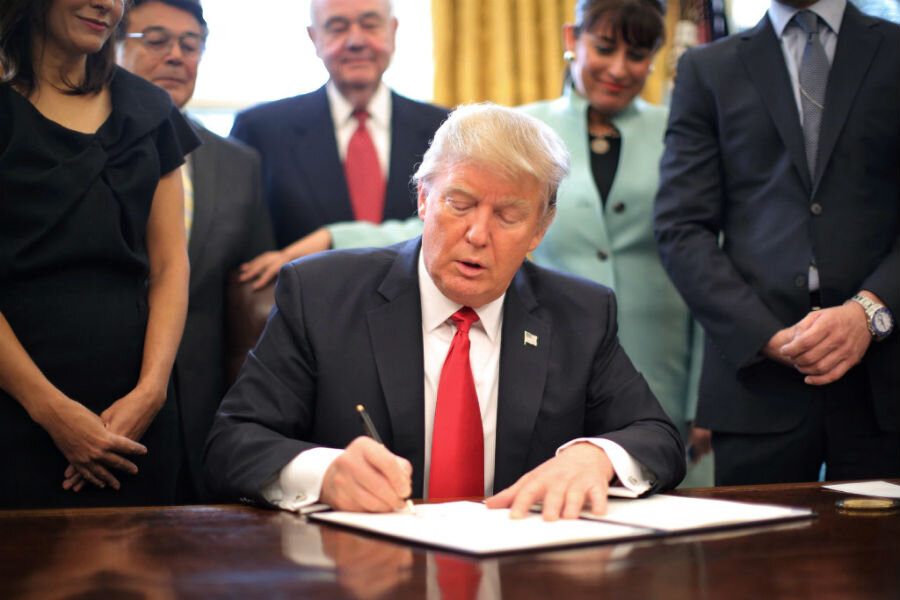Is Trump's use of executive orders extraordinary?
Loading...
President Trump's executive orders have dominated the news since he took office on January 20th. The frequency and controversial nature of many of the orders have sparked debate and protests across the country.
Many presidents begin their terms with a slew of orders in order to push forward campaign promises, overturn policies of the previous administration, and push forward measures that will come to define them as US presidents. But while it is common for members of other political parties to characterize a president's executive orders as overstepping bounds of power, the public backlash against many of Mr. Trump's orders has been more pronounced than any in recent memory.
The concept of an executive order is often misunderstood as something like a royal edict – a law passed down from on high by a ruler to the people below. But the creation of laws falls to Congress, the legislative branch of the federal government. The president controls the executive branch, with the power to implement or support those laws, explains David McLennan, a visiting professor of political science at Meredith College.
"An executive order is a directive by the president to federal agencies about how to enforce or carry out laws," Dr. McLennan writes to The Christian Science Monitor in an email. "In domestic situations, it is the president's interpretation of a law passed by Congress, but since the president has more discretionary powers in terms of foreign policy, the president often creates policy through executive orders in this domain."
Notable executive orders include the famous Emancipation Proclamation from Abraham Lincoln as well as the infamous Japanese-American internment order during World War II under Franklin D. Roosevelt. Most executive orders, however, have much lower profiles, and it is common for presidents to begin to push their agendas through executive orders during their first days in office. In Barack Obama's first week, for example, he signed five executive orders, only one fewer than Trump during the same period.
So what's different this time?
"Generally, presidents have their 100-day honeymoon where they lay out their agenda and lay out their plan in the State of the Union," explains Samuel Abrams, a research fellow at Stanford University's Hoover Institution on War, Revolution, and Peace, in a phone interview with the Monitor. "They work together, build consensus, and try to push the legislation across. If they don't do it that way, they'll have one or two large executive orders."
For Trump, Dr. Abrams says, "one or two" large-scale orders has become closer to a dozen in the first two weeks of the Trump presidency. And many of them, including the order to temporarily ban people from certain majority-Muslim countries from entering the US, are highly controversial.
But while the content of the executive orders is drawing ire from Trump critics, Abrams says that the act of issuing this many orders remains well within the normal boundaries of what the US president can do.
Those orders are still subject to the usual checks and balances in the federal government, he notes.
"Businesspeople [like Trump] always over-act, they are setting their norm, they're putting their stake in the ground, and they're seeing how people react to it," says Abrams. "People do this all the time in negotiations, especially in New York."
During his presidency, Mr. Obama was often accused by Republicans of using executive orders to overstep the bounds of the executive branch, yet the president averaged only 35 orders per year – the fewest since Grover Cleveland, who left the White House in 1897. Obama did, however, exercise another form of executive action, known as a "presidential memorandum," more often than any other president in history. In his first week, Trump signed eight presidential memoranda.
According to the Pew Research Center, the biggest user of executive orders in presidential history was FDR, who issued a whopping 3,721 of them, averaging 307 for every year of his presidency.
Modern presidents have issued an average of 30 to 40 executive orders per year, says McLennan, but the previous generation of presidents, from Dwight Eisenhower through Jimmy Carter, averaged 60 to 80 per year.
"Harry Truman issued about 116 executive orders per year, which is more like the pace than Trump is on if he continues his current schedule," notes McLennan.
Of course, simply issuing an executive order or proclamation does not guarantee that it will go into effect. Controversial executive orders are open to lawsuits and resistance from Congress. The ACLU sued to halt the travel ban, for instance, seeking to prove that it is unconstitutional. If successful, the suit could overturn the order permanently.
"Presidents are highly constrained based on what Congress chooses to do," says Abrams, emphasizing that lawyers, ordinary citizens, and politicians on both sides of the aisle are coming together to challenge many of Trump's policies.
Abrams connects the shock and media frenzy based on Trump's executive orders to a lack of political history education in the US, amplified by outrage in social media. For young people, particularly, he says, the outrage feels brand new, even though protests over executive orders have a long history.
People marched against presidential orders during the Civil Rights Movement and against Harry Truman's order that put US railroads under the control of the US Army in 1950, he notes.
"In reality, this is not all that different from what we’ve seen in the past," he says. "This country has seen ideologues rise and fall."








